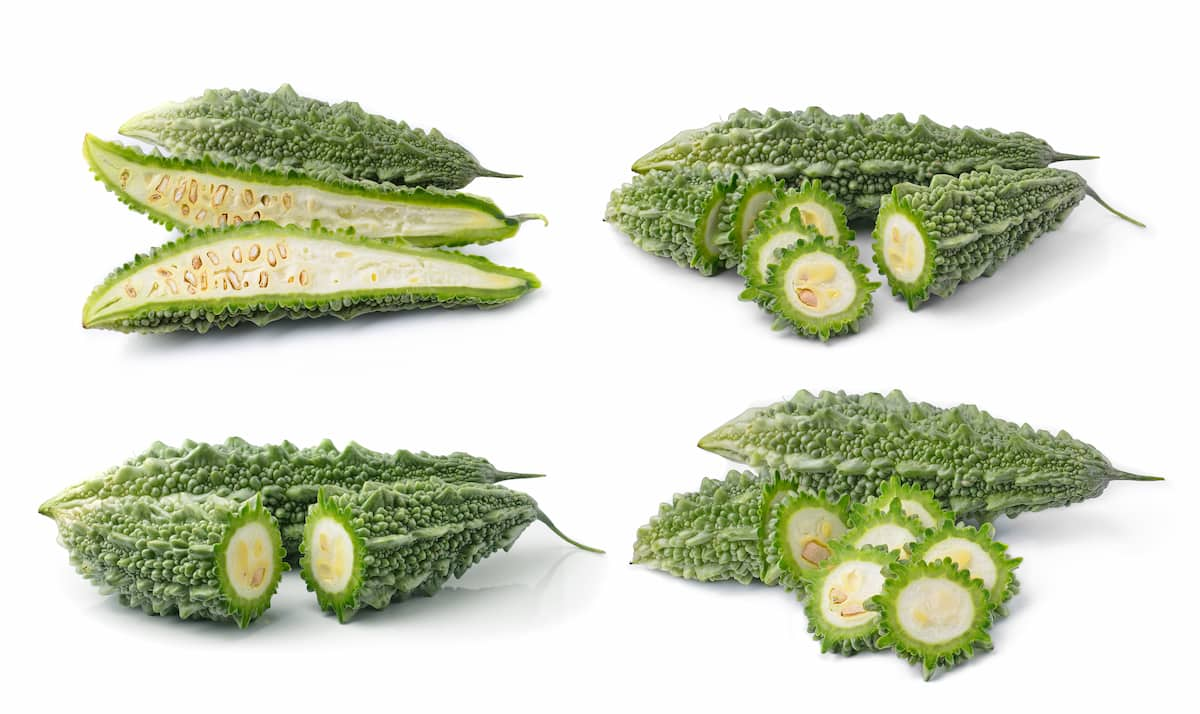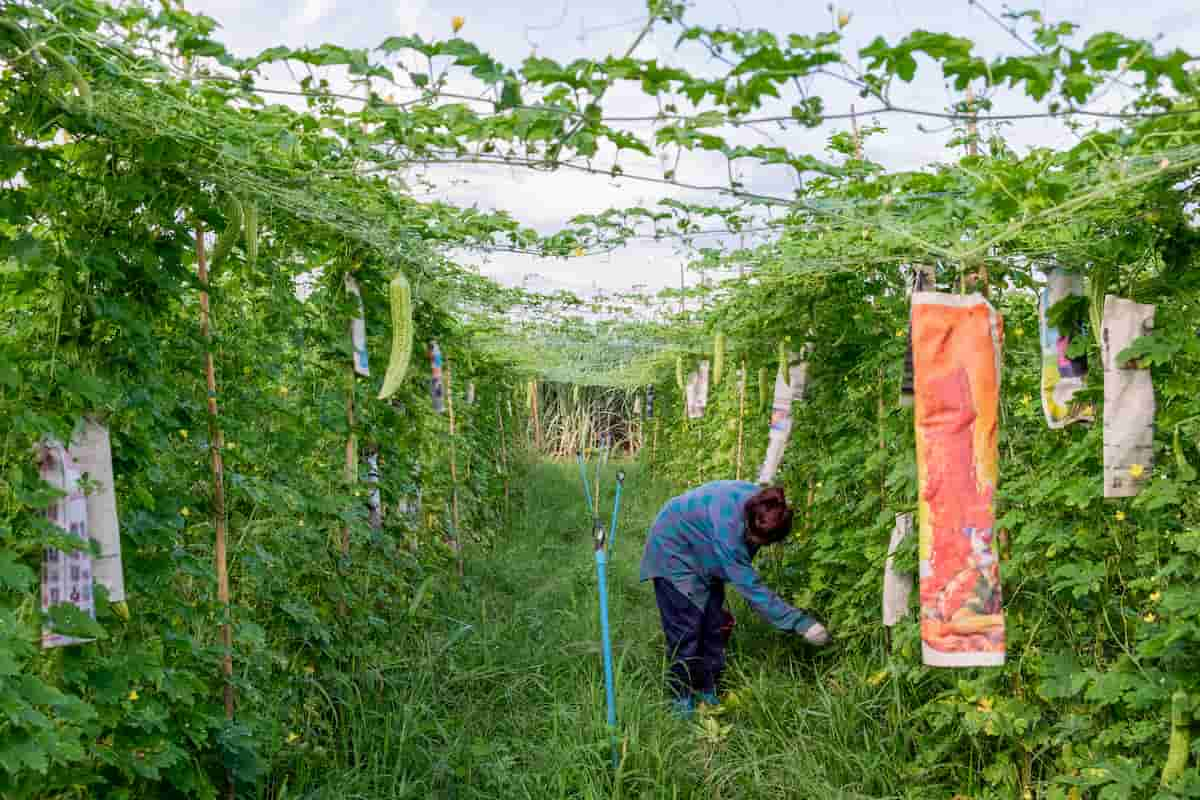Momordica charantia, commonly known as bitter gourd, is a plant species belonging to the family Cucurbitaceae. It is a popular vegetable in many countries known for its distinct bitter taste. Bitter gourd is high in important nutrients like iron and vitamins A, B, and C. It also includes calcium, potassium, and magnesium, which are essential for good health. Bitter gourd has anti-diabetic properties and treats asthma, fever, and digestive problems.

Bitter gourd has become a popular crop in many areas of the globe, including Asia, Africa, and the Americas, due to its high nutritional value and medicinal properties.
Factors Affecting Bitter Gourd Yield
Climate, soil type, and pests/diseases can all affect bitter gourd yield. The climate is a key factor in bitter gourd cultivation because it influences plant growth and development. Bitter gourd is a warm-season produce that grows best in temperatures ranging from 25 to 35 degrees Celsius. Bitter gourd needs well-drained soil that is not waterlogged, so too much or too little rainfall can reduce yield. Another significant factor influencing bitter gourd yield is soil type. Bitter gourd grows best in well-drained loam with a pH of 6.0-7.5.
Soil that is too acidic or alkaline can reduce Production. Soil fertility is also important; using the right fertilizers is necessary for maximum growth and yield. Pests and diseases can also have a big effect on bitter gourd yield. Fruit flies, aphids, and mites are common pests, and diseases such as powdery mildew and bacterial wilt can cause considerable damage. Choosing a pest and disease-resistant bitter gourd variety can help increase yield and decrease the need for pesticides.
10 Best Bitter Gourd Varieties for High Production/Yield
Pusa Do Mausami
Pusa Do Mausami is a high-yielding bitter gourd variety preferred by farmers for its adaptability to weather conditions and resistance to pests and diseases. This variety is known for its long and slender light green fruits, which are delicious and rich in essential vitamins and minerals.
The recommended time for sowing Pusa Do Mausami is from June to July, with a 2-2.5 kg seed rate per acre. The fruits reach edible maturity in about 55 days from sowing, and at this stage, they are dark green, long, medium-thick, club-shaped, and have 7-8 continuous ridges. The fruits are around 18 cm long and weigh about 80-100 grams. Its average yield is around 25-30 tonnes per hectare, which makes it a highly productive variety.
Arka Harit
Arka Harit is a medium-sized bitter gourd variety also released by IIHR, Bangalore. The fruits of Arka Harit are spindle-shaped with green skin, thick flesh, moderate bitterness, and fewer seeds. It has a crop duration of 100-110 days, and the fruits are ready for harvesting in 12-14 days after pollination. The yield of this variety is about 120 quintals of fruits per hectare. It can be grown both in the summer and rainy seasons. The recommended seed rate for sowing should be mentioned. This variety is also suitable for cultivation in various regions of India.
Coimbatore Long
Coimbatore Long is a variety of Karela with tender, long, light-green colored fruits. The Agricultural Research Institute in Coimbatore introduces it. This variety produces substantial crop yields in commercial cultivation, making it one of India’s best varieties of Karela. Its average yield is around 30-35 tonnes per hectare. The fruits are ready for harvesting in 50-60 days from the date of transplantation. This variety is suitable for cultivation in the Northern plains during the spring and summer. The recommended seed rate for sowing is around 2-2.5 kg per acre.
In case you missed it: How to Grow Yellow Muskmelon from Seed: A Step-By-Step Guide

Pusa Vishesh
Pusa Vishesh is another cultivar of Karela with shiny, thick fruits and an average height. IARI, Delhi, introduce it. The fruits are ready for harvesting in 55-60 days, making them ideal for growing in the Northern plains during spring and summer. Its unique characteristic includes high yield, disease resistance, and adaptability to diverse agro-climatic conditions. Its average yield is around 25-30 tonnes per hectare.
VK1 (Priya)
VK1 or Priya is a high-yielding variety of Karela that produces around 50-55 fruits per plant. The extra-long, shiny green fruits can grow up to 30-40 cm in length. This variety is suitable for cultivation in all regions of India. The fruits are ready for harvesting in 45-50 days from the date of transplantation. Its unique characteristic includes early maturity, high yield, and adaptability to diverse agro-climatic conditions. Its average yield is around 35-40 tonnes per hectare.
MDU.1
MDU.1 is a variety of Karela. The fruits of this variety are green-white, weighing around 200-400 grams and growing up to 40 cm in length. The average yield of this variety is around 30-35 tonnes per hectare. The fruits are ready for harvesting in 60-70 days from the date of transplantation.
COBgH 1
COBgH 1 is an F1 hybrid variety. It is a cross between MDU1 and MC84. The fruits are thick and weigh around 200-300 grams, with an average yield of 35-40 tonnes per hectare. This variety produces its first yield in 110-120 days from transplantation.
Asmita
Asmita bitter gourd has intermediate DM & PM tolerance, dark green shiny attractive fruits, uniform fruit shape, and dense prickles. Asmita fruits are 30–32 cm long and 4–5 cm wide—vigorous plants with green foliage and more branching yield good fruit. Depending on culture, the berry weighs 125–140 gm—bitter gourd farmers like Asmita for its good qualities and high yield. Farmers concerned about crop protection favor it because it resists DM and PM.
BGH-106
It is a bitter gourd variety with cylindrical mid-long fruits and dense prickles. It has a tolerance to diseases such as DM and PM. The fruits are dark green, shiny, and attractive. The fruit length is around 13 to 16 cm, with a girth of 3 to 4 cm, weighing around 60 to 80 gm. The plant has good vigor and fruit set.
In case you missed it: Seedless Watermelon Farming: A Step-By-Step Guide for Seed to Harvest

Chikna
It is a bitter gourd variety known for its high yield, excellent fruit quality, and tolerance to viruses and heat. The fruits are typically cylindrical, with a length of 14 to 16cm and a girth of 3.8 to 4.5 cm. They have a smooth surface and a dark green to-green color. This variety is a good choice for farmers who want to cultivate a bitter gourd variety that can withstand hot temperatures and is resistant to viruses.
Conclusion
The best bitter gourd variety maximizes yield. This guide covers ten high-production types. When choosing a species, farmers can maximize yield by considering climate, soil type, and sowing time.
- Feed Your Flock for Less: Top 10 Tips to Save on Chicken Feed
- Ultimate Guide to Ossabaw Island Hog: Breeding, Raising, Diet, and Care
- Hatching Answers: The Top 10 Reasons Your Chickens Aren’t Laying Eggs
- Eggs and Economics: Breaking Down the Cost of Raising Backyard Chickens
- Defend Your Greens: Proven Methods to Keep Iguanas Out of Your Garden
- Ultimate Guide to Cinnamon Queen Chicken: A Comprehensive Guide for Beginners
- Ultimate Guide to California Tan Chicken: Breeding, Raising, Diet, Egg-Production and Care
- Ultimate Guide to Marsh Daisy Chicken: Breeding, Raising, Diet, and Care
- 10 Types of Chicken Farming Businesses You Can Start for Profits